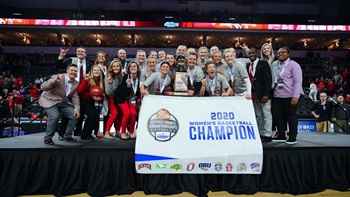Physical Therapy Professor A Geriatric Sports Specialist
In 2009 she and several USD physical therapy students offered courtesy screenings to athletes competing in a local senior games. Evaluating the physical condition of athletes at such an event was a new concept, and the competitors didn’t respond to the opportunity.
“We screened two people,” Jordre recalled, chuckling. “One was a groundskeeper at the facility, and the other was an athlete.”
Undaunted, Jordre and a small team of students traveled to a state competition the following year, and interest trickled upward. Jordre noticed that athletes started to notice the service she and her students provided. The ones who volunteered appreciated the chance to be checked out.
Persistence paid off. Positive word of mouth about the testing service moved through the closely-knit community of senior athletes, and Jordre’s booth at the 2011 National Senior Games held in Houston was very busy. By then Jordre had developed a formal screening procedure called the Senior Athlete Fitness Exam (SAFE).
Now, wherever Jordre goes, including national and state events, she attracts a steady crowd of athletes. The 2015 national event in Minneapolis delivered a stream of familiar faces, offering analysis and a window into the effects of maintaining a fitness agenda in older adulthood. Jordre has been able to evaluate some senior athletes over a period of time, not just at a single event. Her testing has involved thousands of senior athletes.
“We’re discovering significant information as we compare senior athletes to the general population, and observe the advantages of exercise and fitness while aging,” Jordre explained. “We’ve found, for example, that senior athletes have a much lower rate of falls than non-athlete seniors.”
Jordre has also noted there is less depression among senior athletes than non-competitive seniors. “We conducted a short survey on quality of life measures,” reported Jordre, “and found dramatically lower rates of depression and stress.”
The SAFE focuses on physical fitness and involves testing senior athletes for cardiovascular risk factors, strength, balance and flexibility. This inventory helps Jordre and other researchers track and predict injury risks, define healthy models and develop norms for senior athletes.
Jordre explained that the tests are “observational” and that no treatments are administered. “We do share the test results with the athletes,” added Jordre, “and they understand where they stand relative to their peers. This project provides increased health awareness to senior athletes, and that can help them stay healthy. It also helps us learn more about a very unique population.”
One of the features of the tests that most pleases Jordre is that her students help administer them. “This is a terrific experience for the students,” reported Jordre. “They gain experience with a unique population, and I think it changes their views on aging.”
Jordre has published papers and presentations detailing the results of her assessments, and a handful more are in various stages of preparation. Her physical therapy students consistently participate in these publications and presentations.
Jordre has been mentored and assisted with her research at USD by Will Schweinle, Ph.D., associate professor of Physician Assistant Studies and director of research development for the School of Health Sciences, who helped design the project and has done much of the statistical compilation and comparisons on Jordre’s research about senior athletes.
Jordre is now helping train physical therapists from around the country to perform and interpret the SAFE test, allowing for an expansion of testing and for greater levels of understanding senior athletes. She regularly presents at National Senior Games and American Physical Therapy Association conferences, reflecting the increasing recognition that Jordre’s testing and research provides invaluable information.
In recognition of her testing, mentorship, interprofessional applications and research, Becca Jordre received the School of Health Sciences’ 2015 Faculty Research Achievement Award. In her nominating letter, Physical Therapy Department Chair Dr. Lana Svien specifically cited Jordre’s dedication to geriatric wellness, her scholarship as a researcher, her ability to establish a long term and ongoing relationship with the National Senior Games organization, and her ability to teach students and include them in the research aspects of the project. Dr. Svien emphasized that Jordre’s transition from working outside the academic community to being part of it was rapid and impressive. “Her path to becoming a passionate scholar,” wrote Svien about Jordre, a former full-time clinical physical therapist who began as a faculty member at USD only six years ago, “is an inspiration for all clinicians entering the academic setting.”
This story originally appeared in the Fall 2015 issue of the South Dakotan Health magazine. Read the full issue.


